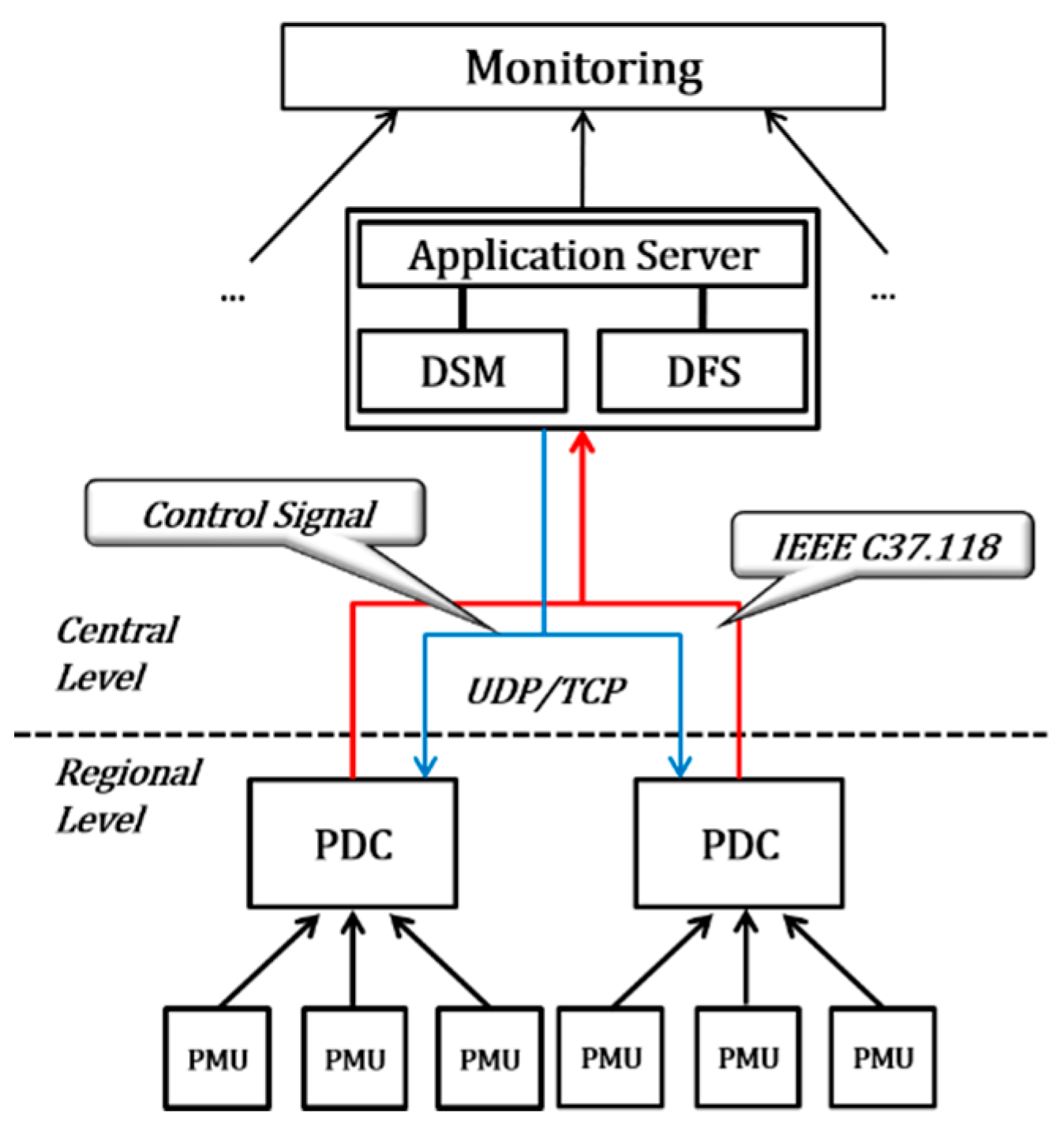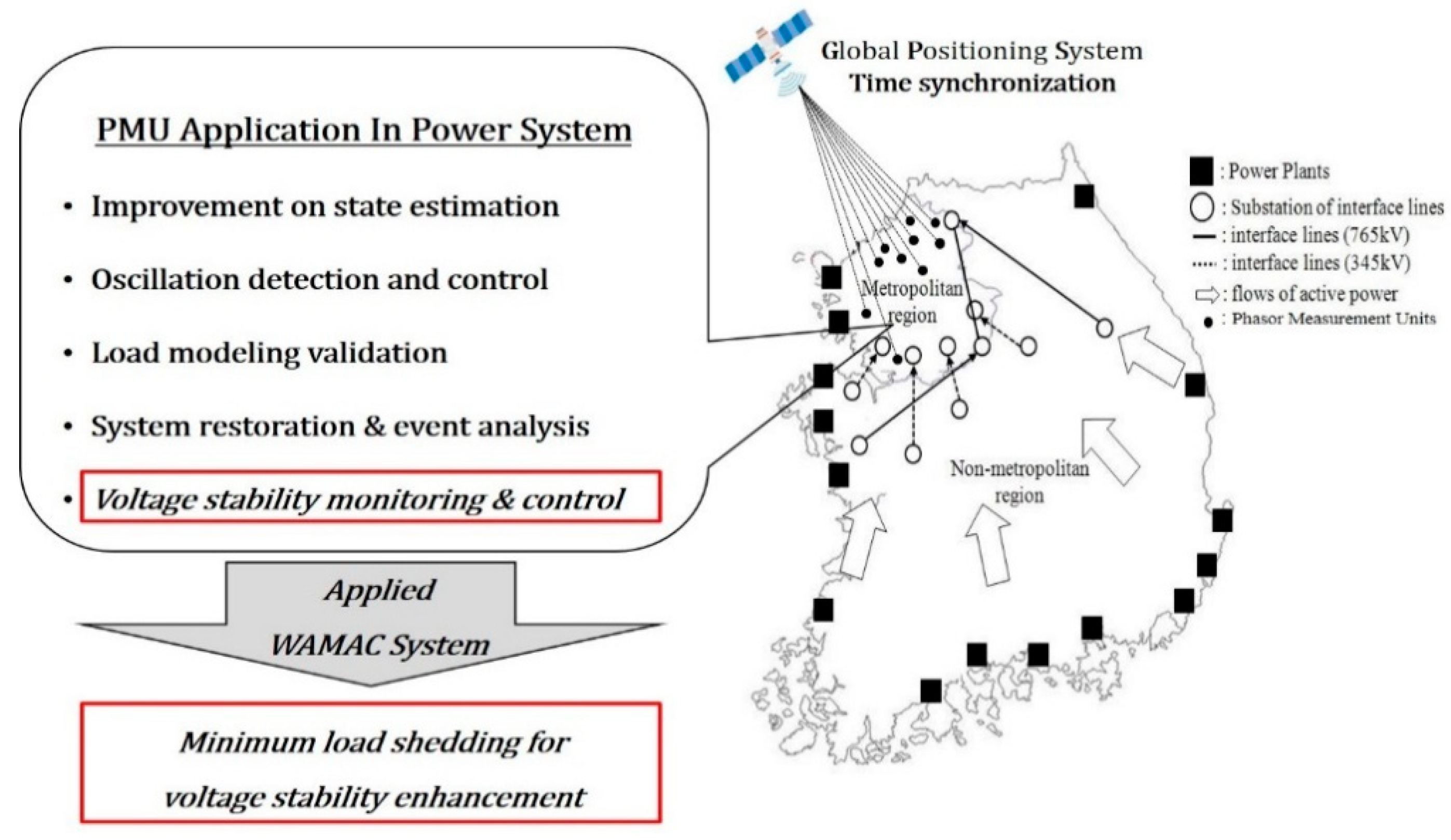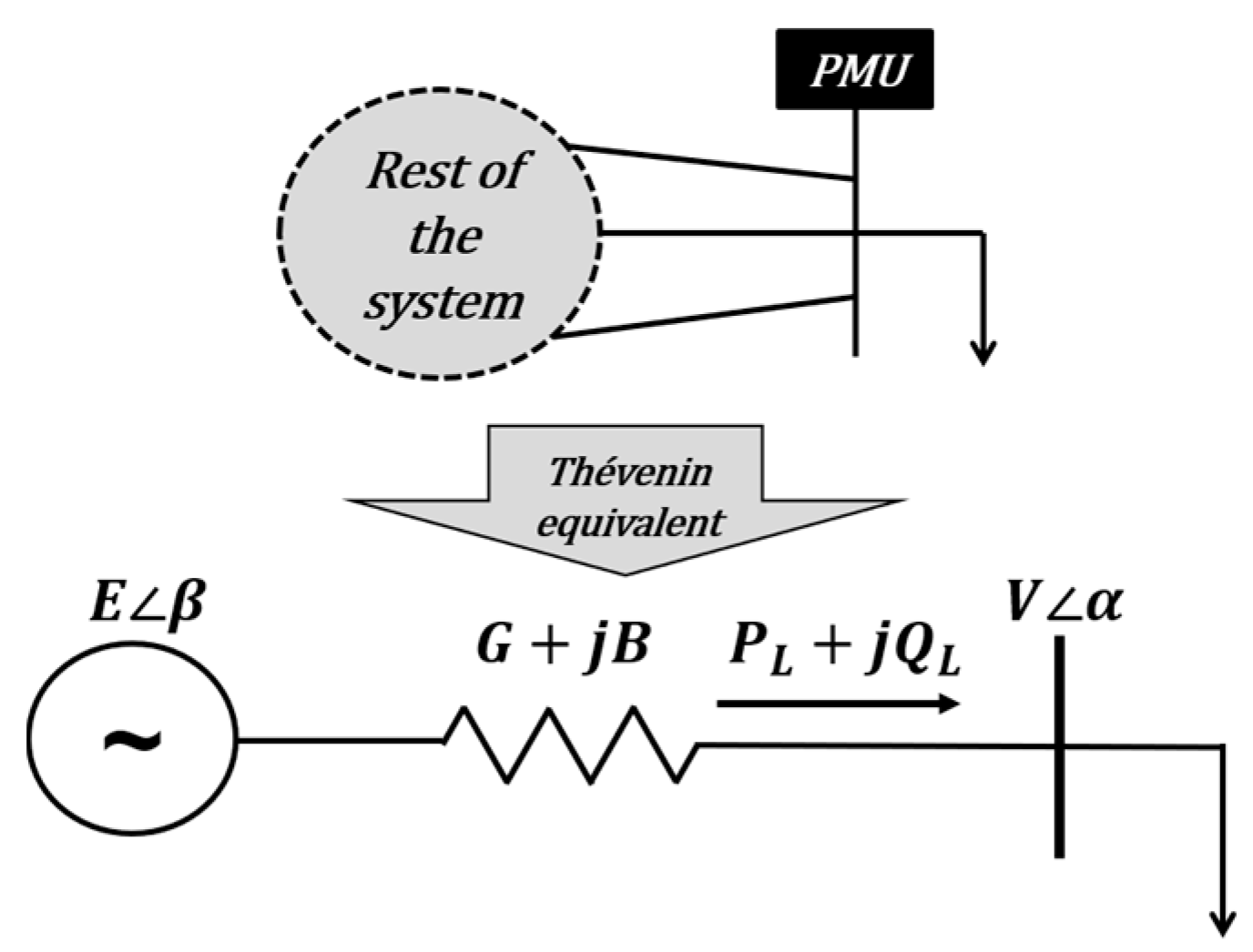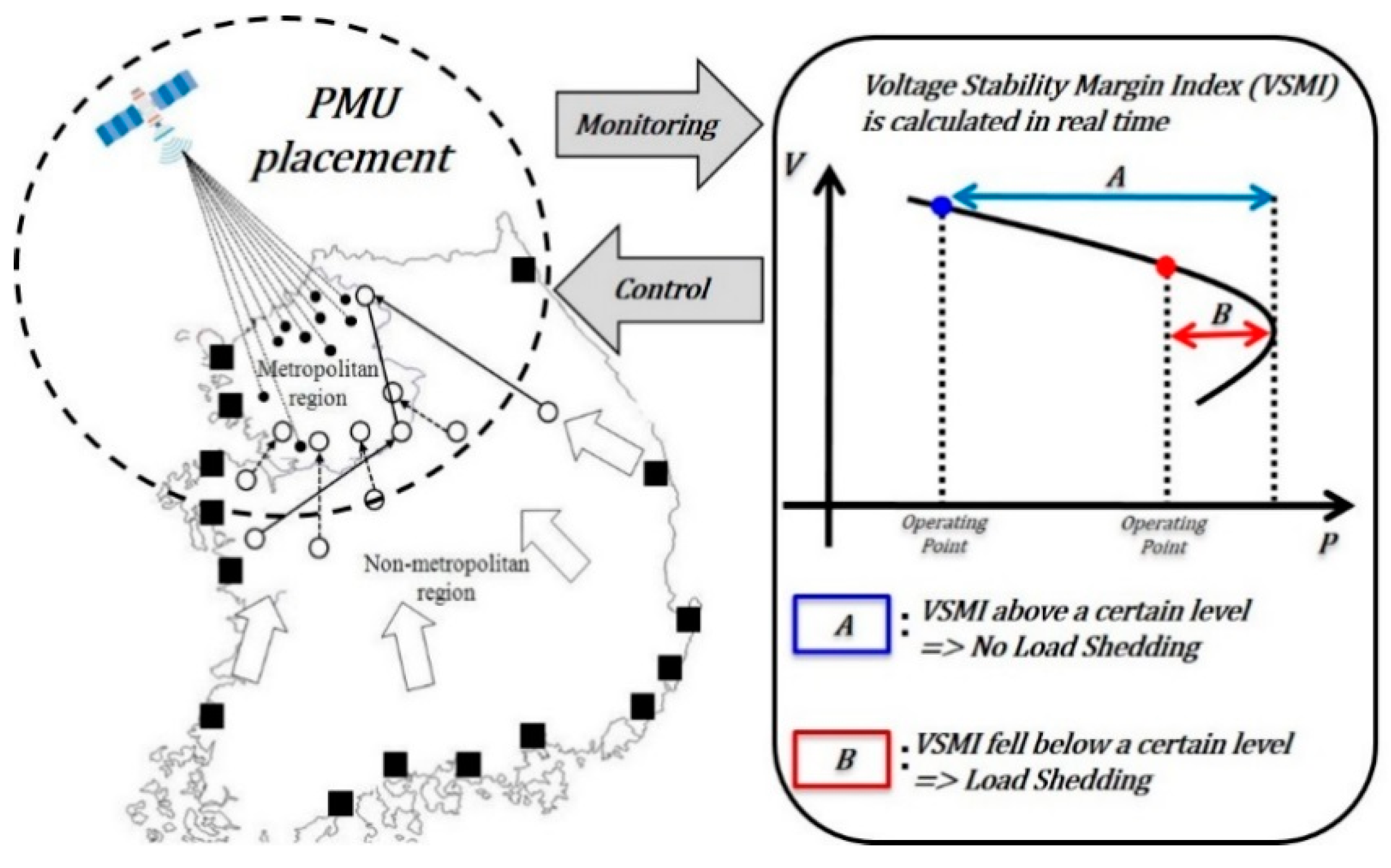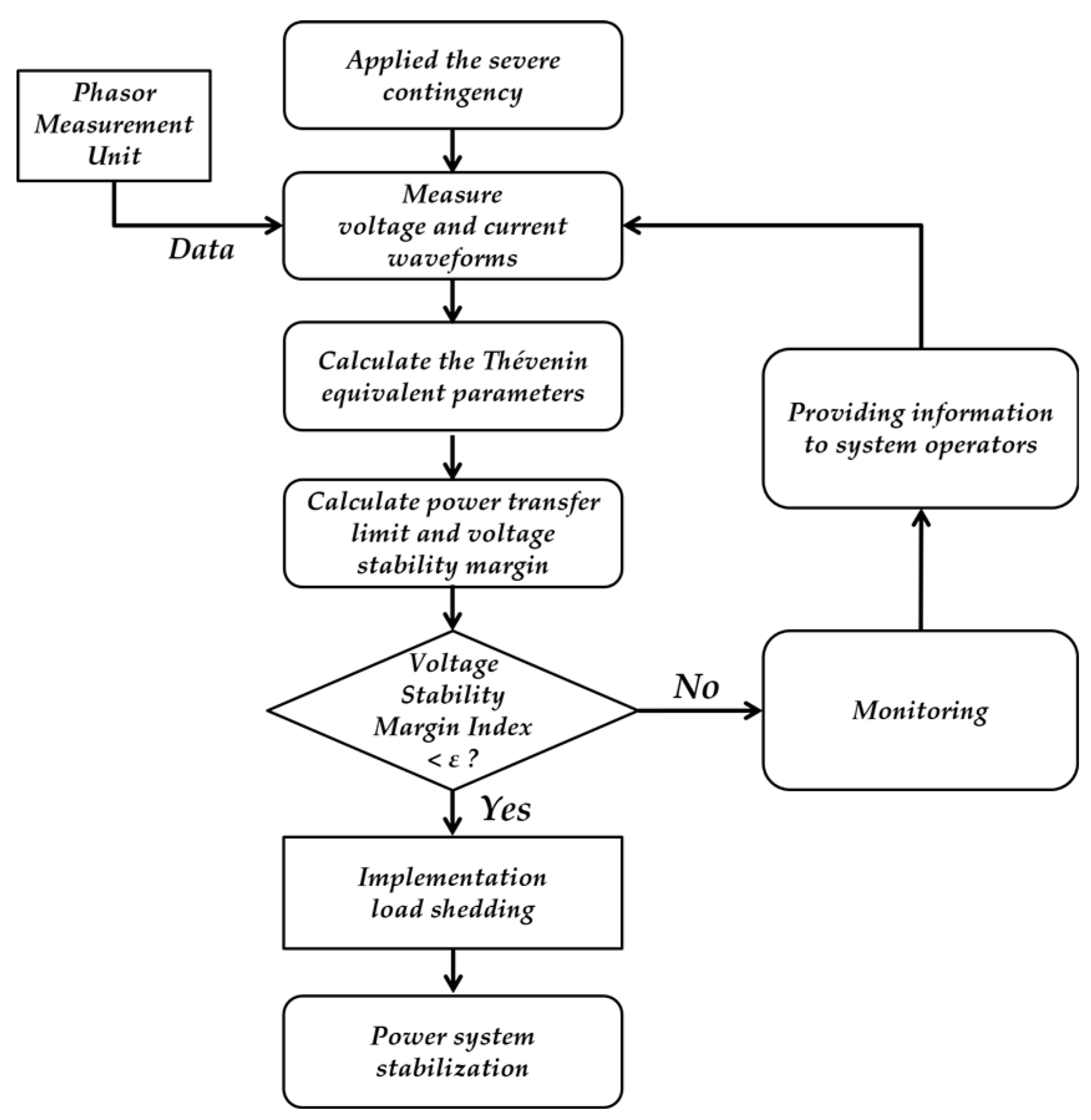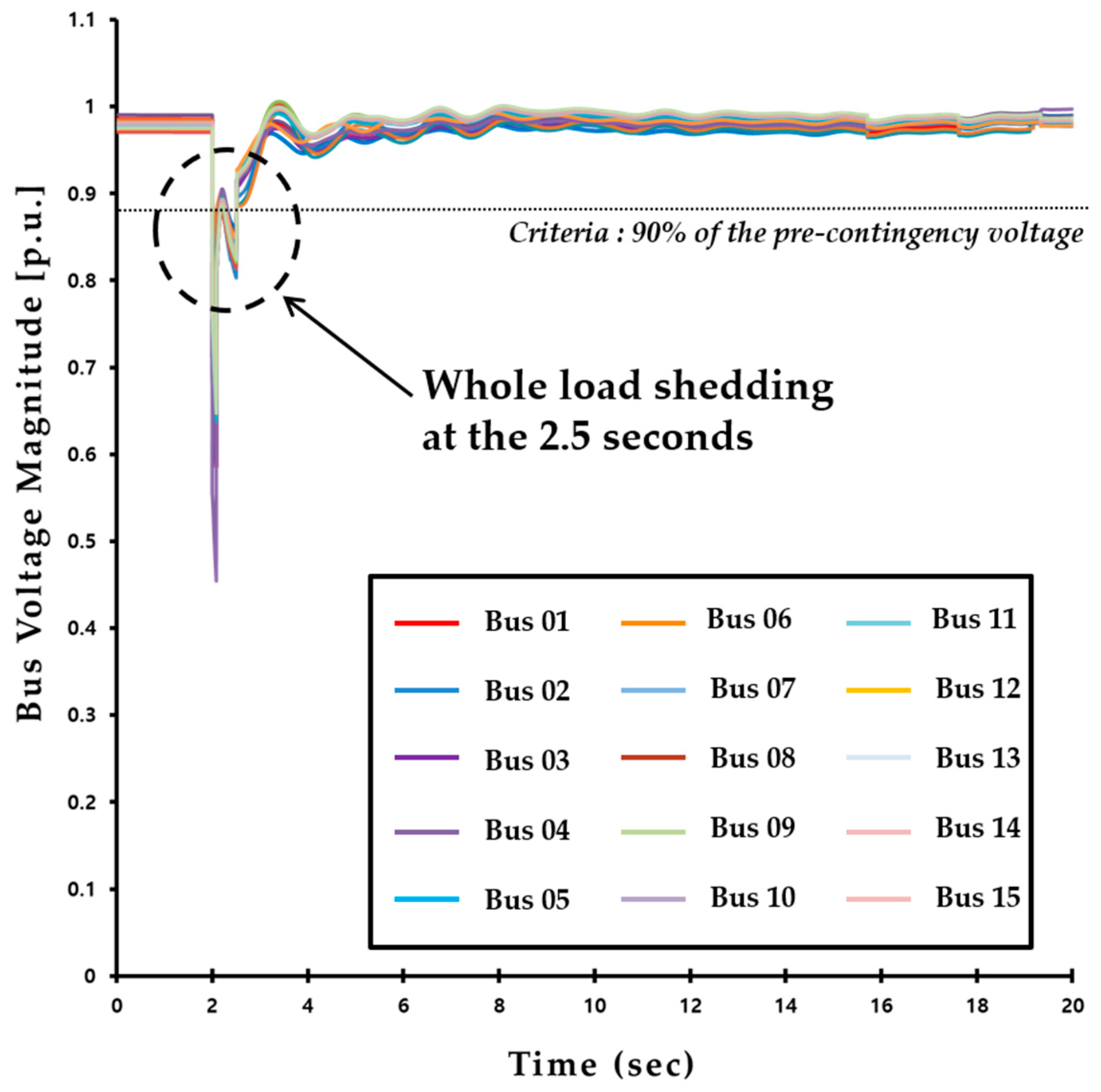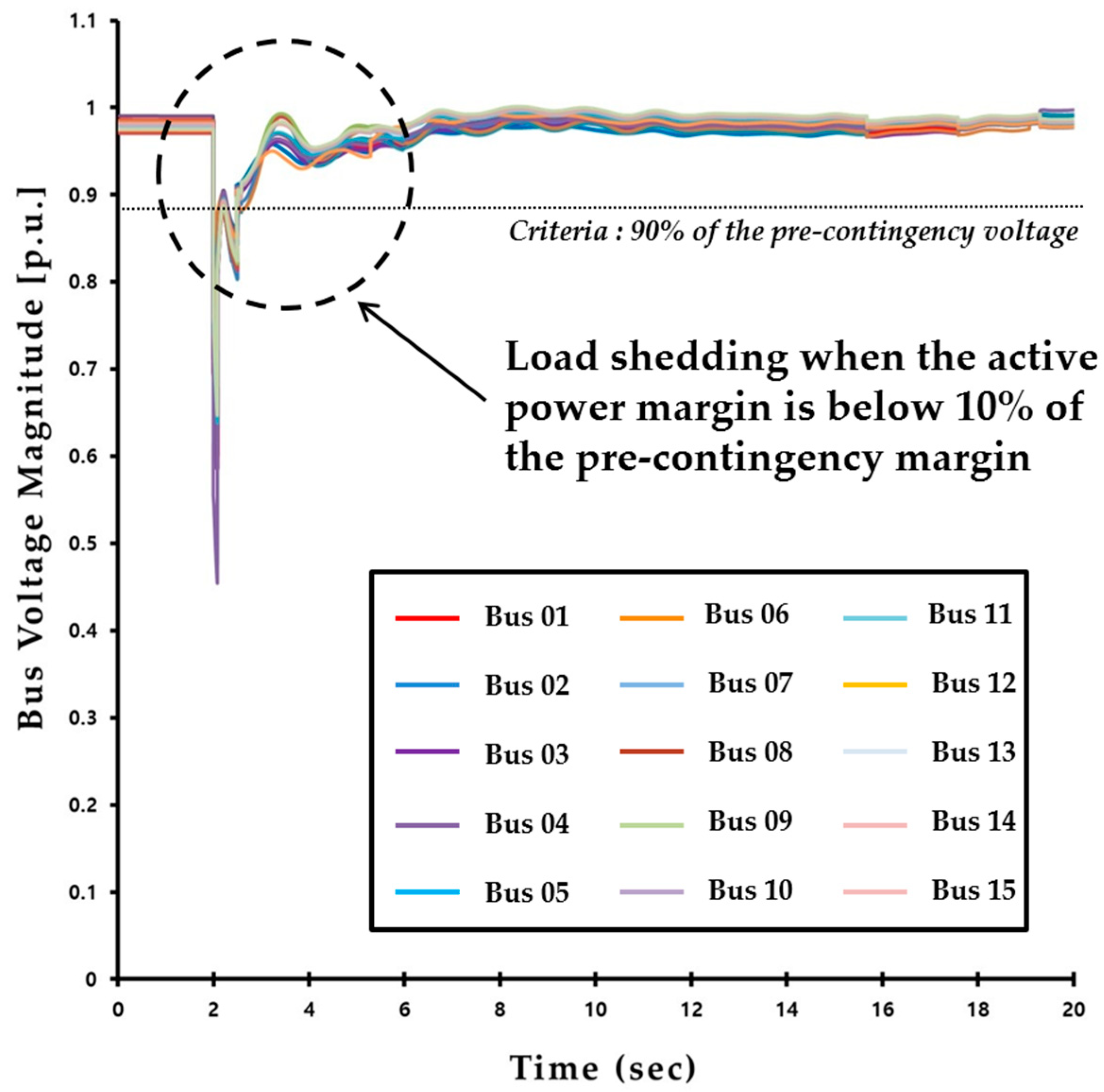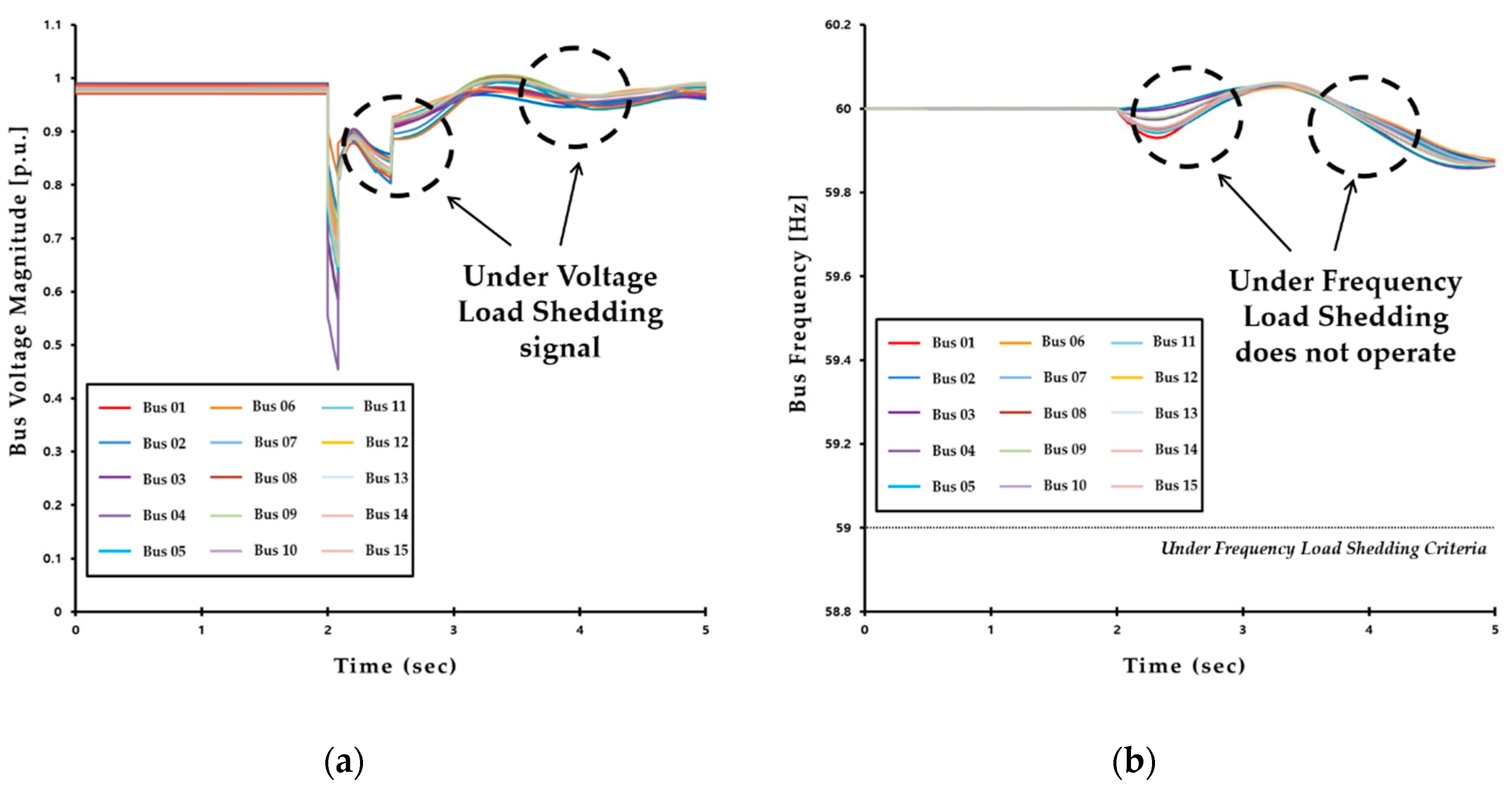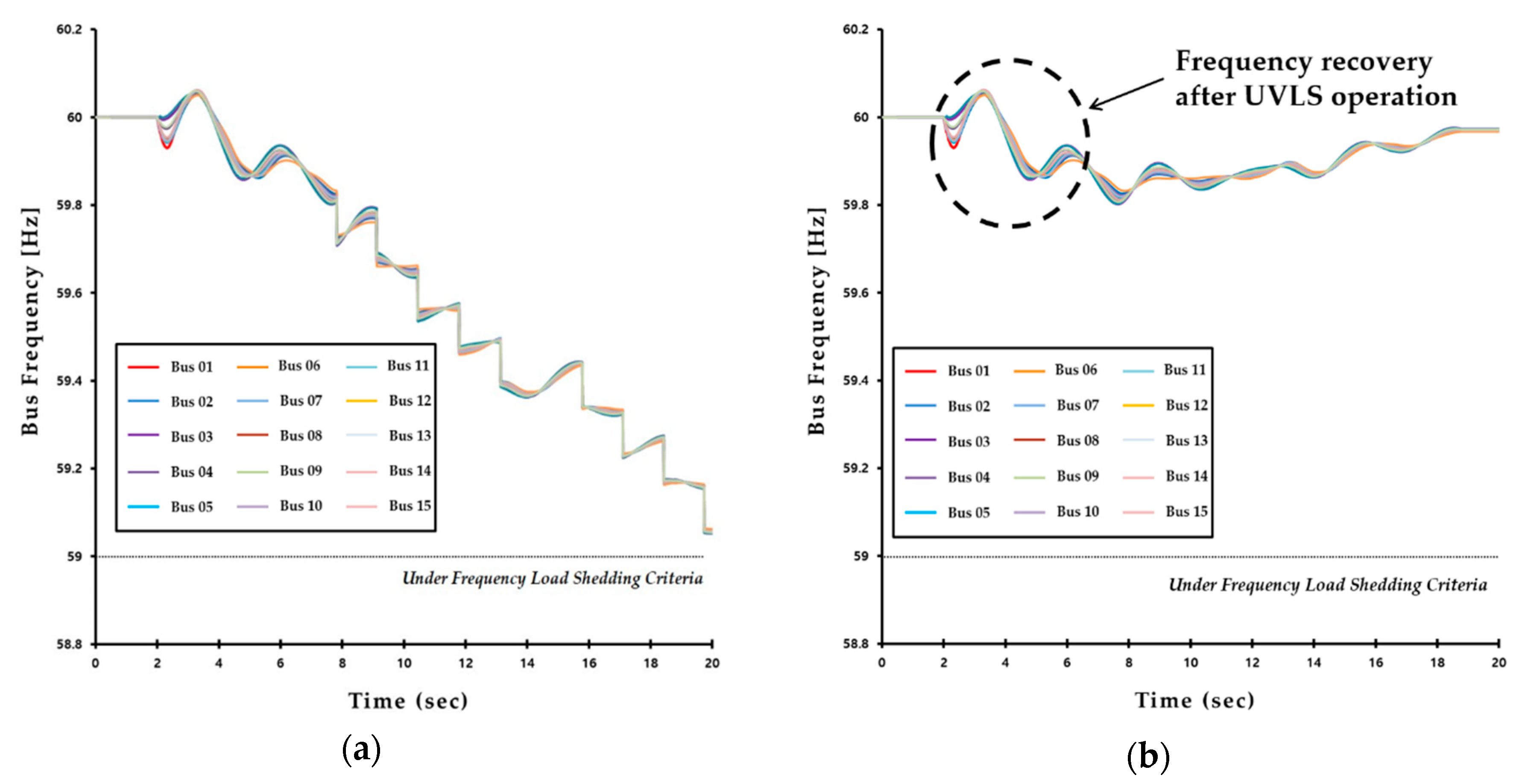1. Introduction
Nowadays, the heavy loading of transmission and distribution networks has made power systems operate close to their stability limits, resulting in a higher risk of voltage instability. Under these conditions, security and reliability might be seriously compromised since unexpected disturbances cause the degradation of the voltage stability. Therefore, adequate countermeasures should be taken to stabilize the power system [
1,
2,
3,
4]. Some of the most important available countermeasures that have been applied are under voltage load shedding (UVLS), shunt capacitor switching, flexible AC transmission systems to extend the voltage stability margin and tap changer blocking, where UVLS is the last line of defense [
5]. Thus, the UVLS method could be considered an effective countermeasure in situations when voltage instability is anticipated. The conventional UVLS scheme is executed in the case of a violation of voltage stability criteria. A UVLS scheme is used in conditions where the voltage magnitude becomes lower than a predefined value [
6,
7,
8,
9,
10,
11].
In the Republic of Korea, a wide area monitoring and control (WAMAC) system has been developed and is operational; phasor measurement units (PMUs) were installed in major substations in the metropolitan area for providing real-time power system information to the operators [
12]. The method of load shedding in current WAMAC systems is designed based on centralized management schemes. Furthermore, the applied special protection scheme (SPS) of the Korean power system has been designed to operate during contingencies involving an outage in one route of a 765 kV double circuit line in the load concentrated area. The SPS is operated at each end of the transmission line by a protective relay. The contingency signal detected by the protective relay is transmitted to a supervisory control and data acquisition/energy management system (SCADA/EMS) system. However, the SCADA/EMS system cannot respond to contingencies in real time and is not able to take the role of an efficient monitoring system. This scheme uses a fixed voltage threshold, fixed time delays and a fixed amount to shed the loads, resulting in the possibility of excessive load shedding. Additionally, this method does not include real-time system conditions and other important information and lacks the flexibility to execute load shedding control schemes fit for the different types of instability [
13,
14,
15].
Several schemes have been developed in previous studies to overcome the limitations of the conventional UVLS scheme. To improve the precision and efficiency of load shedding practices, some studies have developed wide area monitoring mechanisms. These approaches make use of the synchrophasor measurement technology (SMT) attained based on PMUs [
16,
17,
18,
19,
20,
21,
22,
23,
24]. PMUs could provide synchronized measurements, which include the magnitude and phase angles of voltages and currents. These measured data might support the tracking of dynamic phenomena and provide sufficient information for voltage stability assessments. Moreover, PMUs have been proven to facilitate a more accurate and early voltage instability detection [
25,
26,
27,
28]. Nevertheless, they have seldom been applied in existing load shedding methods. Utilizing the PMU applications based on SMT in WAMAC systems might significantly improve the performance of power system monitoring and control over existing schemes [
29,
30,
31,
32,
33,
34]. Additionally, frequency control is one of the important problems in system operation, and for that purpose, load shedding can be also used. The allocation of available electricity power among candidate shed loads has been taken as a bankruptcy problem, and a multi-agent system has been used, as in [
35]. In [
36], a new load shedding scheme based on the bankruptcy problem was proposed using non-critical loads in grid disconnected mode. Installing the PMUs and getting to know the WAMAC systems’ behaviors through the continuous observations of power system events has been the first step. Monitoring, protection and control applications can be developed based on the measurement information obtained from substations. The next step is to pursue the stabilization of the grid by performing an appropriate application when voltage instability occurs in the power system.
For this purpose, this paper proposes a new control load shedding scheme, which aims to enhance the existing load shedding scheme. The decentralized load shedding scheme could control the load at the substation by using the measured data. SMT was used to enable more advanced load shedding based on the voltage stability margin index (VSMI). In addition, the voltage stability margin, a key component in determining the optimal amount of load shedding, was calculated in real time. The maximum power transfer value calculation for determining the real-time voltage stability was performed based on the voltage and current data acquired from the PMU. The method estimates Thévenin equivalent system impedance, then calculates the VSMI and compares the VSMI with the pre-set threshold to decide whether to activate a load shedding action. The optimal amount of load shedding is determined with the help of a threshold value that has to be estimated online using the VSMI. The proposed method can reduce the amount of load shedding by selecting the proper location and shedding an adequate amount for selected locations within seconds after the critical fault. Thus, the method adopts an adaptive and contingency independent scheme, and it provides the results of the applied shedding with maximum transferable active and reactive power at those buses experiencing the shedding action. Other features of the proposed method are as follows: (i) the proposed method can consider the dynamic behavior of the power system based on the obtained PMU data; (ii) the proposed method can provide a fast enough response to prevent short-term voltage instability; and (iii) the computational burden of the proposed method does not change significantly even if it increases the load capacity of the power system. Case studies on the Korean power system have validated the performance of the proposed decentralized load shedding scheme, showing that it effectively reduced the amount of load shedding under contingency scenarios involving the severe failure of high-voltage transmission lines.
The structure of this paper is organized as follows. The role of the synchrophasor measurement technology for implementing the proposed load shedding method and the application of the phasor measurement unit for obtaining the information required in improved wide area monitoring and control of the power system are described in
Section 2. It also includes the fundamental theories and mathematical principles of the proposed load shedding scheme based on the voltage stability margin index.
Section 3 presents the simulation results and discussions on the verification of the performance of the proposed scheme using a practical system. Finally,
Section 4 includes the conclusions and future research directions.
3. Results and Discussion
In this section, the validity of the proposed method is demonstrated for a practical system; the simulations were conducted using real Korean power systems data. The Korean power system is peculiar in that the load demand is concentrated in and around the metropolitan region. The major generators are mostly located in the non-metropolitan region, and it is for this reason that a large amount of active power flows through a set of interface lines connecting them to the metropolitan region. Among these, the 765 kV transmission lines are the critical interface lines for transferring power from the large generation plants to the metropolitan region. When a fault occurs in the parallel 765 kV lines, unless immediate countermeasures are applied, this leads to the voltage instability phenomenon.
Figure 6 shows the observed bus voltage profile without load shedding.
From
Figure 6, the contingency scenario along with the time domain are summarized as: a fault occurred in the 765 kV line at 2.0 s; after five cycles, the shunt reactor was disconnected and the fault was cleared; five of the eight generators were tripped at 2.15 s, respectively. The generator and transmission lines played a significant role in the power system, based on the large respective generation and transmission capacity in the steady-state condition before the disturbance occurred [
45]. Therefore, their contingencies led to an active power insufficiency accompanied by a reactive power insufficiency. Therefore, this disturbance caused the voltage instability phenomenon; no load shedding action was taken; eventually, all buses were beyond the threshold; and the system fell into a dangerous condition. Therefore, this transmission line fault signal would be transmitted to the metropolitan region’s control center. In the case of a transmission line trip or an under-voltage condition, the load shedding control signal would be transmitted to the metropolitan region considering the predetermined location, amount and delay time.
Typically, the load shedding scheme would be activated when a value lower than the predefined value is detected. The load shedding method must be able to increase the voltage of all buses above 90% of the pre-contingency voltage [
46]. For the case study, the load shedding was performed by selecting 15 buses in the metropolitan region that exhibited the most sensitive changes in the event of a line fault, and the PMUs were installed at the load buses. In this paper, after the occurrence of a fault, the results obtained via the conventional method are compared to those obtained via the proposed load shedding method.
3.1. Existing Load Shedding Method
In the existing load shedding method of the Korean power system, the amount of load that is shed is decided based on the results of a steady-state analysis, and the dynamics of the power system are not considered. The decision making of the load shedding is usually provided by system operators, depending on pre-established practical criteria. In the existing scheme, any information on the sensitivity to the variations in voltage is transferred to the central controller, which decides whether to shed the load depending on the logic based on under-voltage relays, which send the signals to the actual load shedding areas. Then, the designated load in the metropolitan region is shed after the fault occurrence.
Table 2 shows the descriptions of the implementation procedures of the time-domain simulation in the applied voltage instability scenario.
From
Table 2, one can notice that the same voltage instability scenario was used until Step 3. In this case, a load shedding method was implemented at 2.5 s, and it shed the entire load at the same time. By shedding 100% of the load bus, control was performed to prevent voltage instability in the system. Then, the bus voltage was monitored at the end of simulation.
Figure 7 shows the observations for the bus voltage profile with the existing load shedding method.
From
Figure 7, one can notice that when applying the existing load shedding scheme, voltage instability was alleviated. Reviewing the voltage after load shedding, all bus voltages had recovered to above 90% of the pre-contingency voltage. In this case, Buses 1–15 implemented load shedding. The amount of load shedding was about 1270 MW.
Table 3 summarizes the location, delay time and amount of the existing load shedding scheme.
3.2. Proposed Load Shedding Method
In the decentralized scheme, the load could be controlled at the individual substation level using the data measured by the PMUs. This method was able to calculate the VMSI in real time at a local load bus by using the measured voltage and current waveforms. This could provide system operators with the power transfer limit for the load bus, not only in terms of active power, but also reactive power support required at that load bus. Furthermore, load shedding might be executed to prevent voltage instability, and coordination with other substations continuously performed to monitor and maintain control over wide area voltage stability. When this method detected that the voltage stability conditions violated an emergency level, it would perform the local load shedding function.
Table 4 shows the descriptions of the implementation procedures of the time-domain simulation with the proposed method in the same voltage instability scenario.
From
Table 4, one can notice that load shedding was implemented when the active power margin fell below a certain level. The active power margin was a key component in determining the optimal amount of load shedding, which was calculated in real time. Additionally, it provided information about how much load needed to be shed based on the PMU data.
Figure 7 shows the variation results of the active power margin.
In the applied simulation for the proposed method, the disturbance occurred at 2 s. The active power margin of most buses dropped significantly, as shown in
Figure 8. Therefore, depending on the line fault, the individual threshold values were exceeded, thus initiating the load shedding procedure. However, Buses 2, 3, 10 and 13 maintained a certain amount of active power margin after the fault’s occurrence. These buses did not implement load shedding because the active power margin did not drop below 10% of the pre-contingency margin after the occurrence of a fault. As a result, in this situation, applying the proposed method reduced the amount of load shedding. The results of the bus voltage profile for the proposed scheme are shown in
Figure 9.
Table 5 shows the results of the active power margin before and after the contingency.
From
Figure 9, reviewing the voltage after load shedding, all bus voltages had recovered to above 90% of the pre-contingency voltage. In this case, Buses 1, 4, 5, 6, 7, 8, 9, 11, 12, 14 and 15 implemented load shedding. The amount of load shedding was about 1111 MW.
Table 6 shows the load shedding bus location, delay time and amount of the load shed for the application of the proposed scheme.
This result indicates that the proposed method was effective in preventing system instability, and were are able to reach a steady state thanks to the load shedding actions. As is clear, the advantage of the proposed method is to reduce the amount of load shedding from that using the existing method. This would lead to less switching in the process of load shedding, and the maintenance cost benefit of the breakers would decrease. Additionally, if the system dynamics were monitored with more accurate measurements, it might be possible to counteract contingent incidents caused by transmission constraints on the system operation.
3.3. UVLS Scheme Interaction with the UFLS Scheme
To maintain voltage and frequency stability after disturbances, the UVLS and UFLS schemes can be performed in the Korean power system. Some of the load shedding resources are shared by the two schemes. This section discusses the interaction between the two schemes. When the load is shed by UFLS first, a problem occurs if there is no shedding resources for UVLS. The current load shedding amount for UFLS (approximately 2500 MW) is much larger than that of load shedding by UVLS. Thus, in most of the cases, the system might not suffer from low voltage problems after performing UFLS, even though no resources remain for UVLS.
When the system experiences low frequency problems a few seconds after critical events, the UFLS scheme is activated, and its time delay is about 0.1 s. However, UVLS can determine whether to shed loads within a 1-s time delay when low voltage problems are detected, and it transmits the signal to control locations. Thus, it is obvious that the load shedding signal is already transmitted before the operation of UFLS in low voltage situations.
Figure 10a illustrates bus voltage trajectories when UVLS is performed first. In this case, the UVLS signal is transmitted within a short period of time as in
Figure 10a.
Figure 10b shows bus frequency trajectories after the fault. In this case, the UFLS does not operate because the frequency is not low enough to satisfy the criteria to generate the load shedding signal. After that, UFLS might be activated based on the state changes of the system.
Figure 11 shows the time trajectory result of bus frequency applying the two-circuit outage of 765 kV transmission lines (Sinseosan-Sinansung) in the Korean power system. When an outage occurs on the 765 kV lines, some generators in the Dangjin plant are tripped for angle stability. As in
Figure 11, when the load is shed by UVLS, the frequency would recover above the UFLS operating range.
Figure 11a illustrates the frequency change before UVLS operation, while
Figure 11b shows the frequency variation after UVLS operation. Thus, one can notice from those figures that the operation of UFLS might be prevented depending on the action of the UVLS. In general, the critical frequency drop activating UFLS usually occurs about 10 s after the fault. The proposed load shedding scheme transmits the load shedding signal when the VSMI falls below 10% after a fault to shed the loads of each substation. Therefore, all load interruptions are performed within 4 s after the fault, and the system can be stabilized.
3.4. Discussion
According to the above results, the two load shedding methods are summarized in
Table 7. The results of the buses’ voltage recoveries after load shedding are similar, but the total load shedding amount is different between the two methods. As can be seen from
Table 7, in the decentralized scheme, the shedding could decrease the amount by about 158 MW. The case studies investigated validate the proposed method, and it was shown to lessen the amount of load shed results compared to the existing scheme.
It is very important to calculate the voltage stability margin index as the basis for determining load shedding in the proposed method. The proposed method’s process is performed based on the VMSI by SMT in a distributed way, and the delay time of shedding the load bus would be determined by VMSI. Therefore, it should be decided very carefully based on the selection of the appropriate reference quantity through the SMT and the experience of the system operator.
Excessive load shedding sometimes leads to an overvoltage problem when the existing scheme is applied. The existing load shedding scheme based on off-line analysis determines the amount of load shedding on the assumption that the system is the most severe condition. In this case, this might lead to economic loss due to unnecessary load shedding even though the actual system does not proceed in an unstable state. The proposed load shedding scheme in this paper can accurately estimate the situation when the load shedding is required by monitoring the system in real time. The system operator can actively cope with an emergency so that unnecessary load shedding can be prevented and effectively stabilize the system. In addition, performing a minimum load shedding to prevent a wide area blackout caused by voltage instability can protect against great economic loss. Furthermore, the decentralized load shedding method based on SMT, considering the system’s dynamic behavior, could improve the voltage stability. In summary, the proposed method exhibited the best performance after load shedding in relation to the steady state from the perspective of voltage stability and contributed to the establishment of an optimal load shedding strategy.
4. Conclusions
In this paper, to overcome the disadvantages of the existing load shedding method, a decentralized load shedding scheme based on the SMT was proposed. SMT was used throughout the proposed load shedding process, and the voltage stability margin was calculated by the PMUs via the measured voltage and current waveforms. Thus, the calculated voltage stability margin can be used as a useful index for the system operators in the critical decision-making process of load shedding. The decentralized load shedding method was applied to the emergency situation to decide whether to shed loads depending on the active power margin. The proposed method significantly reduced the amount of load shedding in comparison to existing load shedding strategies. The case study results show that the decentralized load shedding method could enhance the steady state of power systems’ voltage stability when encountering large disturbances. Additionally, the performances of the proposed load shedding schemes were tested using dynamic simulations of the Korean power system, and the extensive results demonstrated the effectiveness of the decentralized load shedding method. Thus, utilizing the proposed scheme in the PMU application within the practical system, there would be a contribution to protecting the system safely and efficiently.
Future research work will focus on the cyber security of the PMU application. Electronic communication links are an important component of the SMT and bring associated concerns about cyber security. Given that most of the power systems evolve in an electronically-controlled environment, a successful cyber-attack could cause enormous physical and financial damage. In addition, if the control equipment is hacked and an appropriate countermeasure is not taken in case of an accident, the stability of the whole system might be degraded. Therefore, it is essential that cyber security vulnerabilities be carefully analyzed and mitigation countermeasures prepared.
